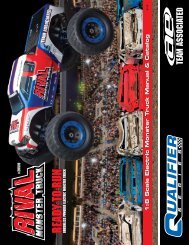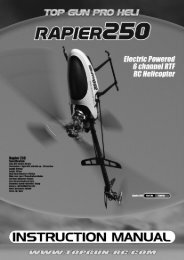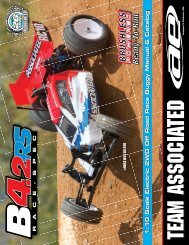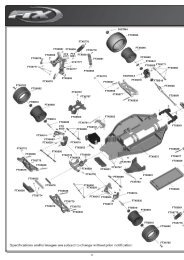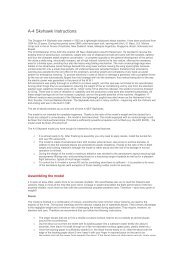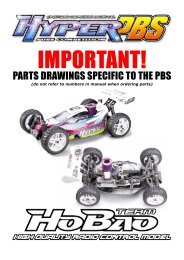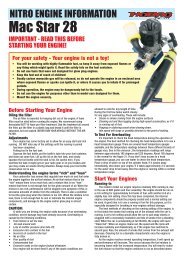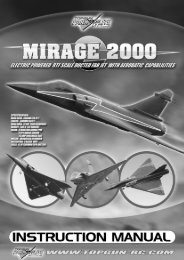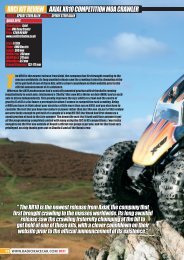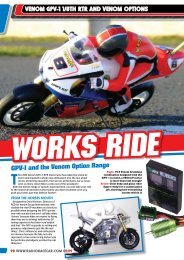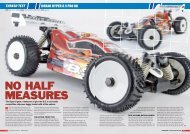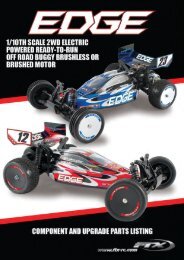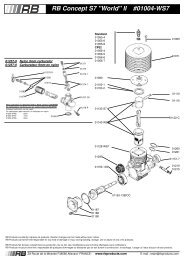Focke-Wulf Fw 190D-9 Instructions - CML Distribution
Focke-Wulf Fw 190D-9 Instructions - CML Distribution
Focke-Wulf Fw 190D-9 Instructions - CML Distribution
Create successful ePaper yourself
Turn your PDF publications into a flip-book with our unique Google optimized e-Paper software.
o slide the loose bay cover forward and remove it from the fuselage (IV).<br />
The decals<br />
The model is sprayed with colours making up its basic camouflage scheme. The codes and markings consist of the<br />
waterslide decals. Their primary advantage is the negligible weight and the minimum risk of damaging the model<br />
during application. They require, however, an attention and care. Therefore we recommend that you follow the<br />
subsequent instructions:<br />
o Applying the decals may be simplified markedly by using the decal setting solutions used in plastic scale<br />
modelling – it is available in the modelling hobby shops. Make sure that the solution does not affect the<br />
styrofoam, then follow the attached instructions.<br />
o Cut the decal with its backing paper from the sheet, dip briefly (max. 5 seconds) to lukewarm water and<br />
leave to soak on a flat non-absorbent surface (glass, plastic etc.).<br />
o The sufficiently soaked decal slides easily on its backing paper. Slide the decal so that its edge overhangs<br />
the backing paper by few millimetres and place this overhanging edge in proper place on the model. Hold<br />
the edge in place with fingers and slowly slide the backing paper form beneath the decal. If the sliding is<br />
not smooth enough, add some water to the decal edge; in case of need the water applied at the edges of<br />
the decal in place would help to lift it from the model surface a replace it as necessary.<br />
o Smooth the decal carefully and squeeze the excess water, glue and air bubbles with a soft blotter or<br />
preferably a soft polyurethane foam roller, from the centre of the decal towards it edges. Do not squeeze<br />
out all of the glue – the decal would fail to adhere enough and some air may get beneath it, causing light<br />
discolouration! If properly attached, the decal shall adhere to the model surface once the glue is completely<br />
dry, i.e. after several hours.<br />
o The model could be sprayed with a layer of transparent gloss or semi-matte (mask the cockpit canopy!!)<br />
acrylic or synthetic varnish as per your preferences and ideas on the appearance of the real aeroplane. Do<br />
not forget that a test of possible aggressiveness of any substance used on the styrofoam models has to be<br />
carried out. Also keep in mind to spray only very lightly to save weight.<br />
A) RC equipment<br />
The general layout of the electrical connection is on the diagram. We strongly suggest that you assemble and<br />
connect the RC equipment outside the model and check its function. Observe the recommendations of<br />
manufacturers as listed in the directions of use for the respective components. Check the compatibility of the receiver<br />
with the crystal used – the over-the-land range test of the transmitter, albeit it may seem unnecessary nowadays,<br />
may save you much more than it would cost…<br />
B) Power unit ( motors with the MP Jet gearbox or MP Jet outrunner )<br />
o The power unit 1 is attached to the motor bulkhead by three screws 2.<br />
o The engine cowling 3 could be tack-glued to the fuselage by the cyano or epoxy or PU glue or by a piece<br />
of adhesive tape.<br />
o Slide the propeller back plate 4 to the gearbox (motor) shaft, install the propeller 5 to the back plate, the<br />
rear part of the spinner 6, and the washer 7, respectively (use the washer from the model kit, not from the<br />
power unit set), and tighten the complete assembly with the nut 8.<br />
o Tack-glue (Epoxy) the front part 9 to the rear part of the propeller spinner 6. Apply the glue to the contact<br />
surfaces, not to the rim. To disassemble the spinner, carefully cut away the spinner front part 9 at the line<br />
joining it with the rear spinner part 6.<br />
o Check that the propeller rotates freely, without binding between rotary and stationary parts.<br />
C) Aileron control<br />
The aileron servo should be powerful enough to overcome the friction in the control bowdens – we recommend<br />
utilising a servo of more than the 0,15 Nm minimum torque. The friction in the bowdens could be reduced by<br />
removing the push-pull rods from the tubes and lubricating them with a thin oil, such as the WD-40.<br />
o Place the connector 10 into hole in the servo single arm, at the distance of about 8 mm from the axis of<br />
servo arm’s rotation. If the opening in the servo arm is too large, it is better to drill a new one (of 1 mm<br />
diameter) rather than bushing-out the existing ones.<br />
o Insert a 6mm long piece of the tube 11 into the connector opening.<br />
o Insert the connector to the control rods, first to one, then to the other (fig. C1).<br />
o According to the dimensions of your servo, modify the opening in the top surface of the wing. It should fit<br />
tightly; the best way is to cut the opening somewhat narrower than the servo width and then to push the<br />
servo in carefully. Insert the servo into the wing opening and place it so that once the servo arm is inserted<br />
on its shaft (the axis of the servo arm should be parallel with the longitudinal axis of the servo) the control<br />
rods would make a smooth curve and that the set-screws 12 and 13 could be tightened. (fig. C2). If the<br />
servo protrudes above the wing surface, it has to fit into the opening at the bottom of the fuselage centre<br />
section. If need be, you may enlarge the wing opening even in front of the servo, but always take utmost<br />
care when cutting into the hard surface of the plastic. If the servo is of such a width that it would fit into the<br />
bomb/tank rack contour at the wing bottom, it could be sunk into the undersurface of the wing.<br />
o Devote maximum attention to the correct positioning of the servo – only that way you would ensure the



